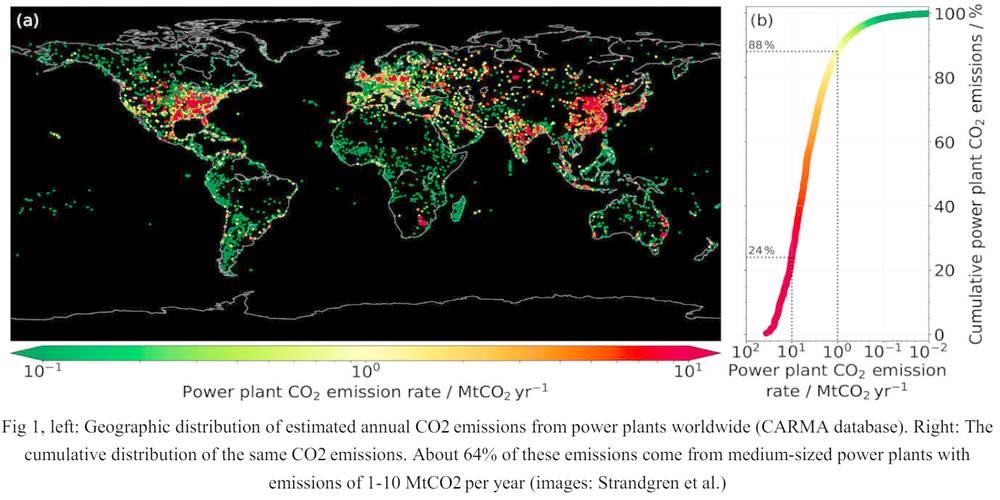CO2Image
Human-induced climate change is one of the most urgent social problems of our time. The biggest culprits are the greenhouse gases carbon dioxide (CO2) and methane (CH4). Precise knowledge about the sources of these gases helps to better understand the processes in the atmosphere and to slow down climate change. 30% of all man-made fossil CO2 emissions currently come from point sources. These mainly include coal-fired power plants, but also industrial plants. Fig. 1 shows the spatial distribution of emission sources around the world, as well as the accumulated emission intensity depending on the size of the power plants. All power plants that emit more than 10MtCO2/year are responsible for 24% of global power plant emissions. If all power plants that emit more than 1Mt CO2/year are taken together, they account for 88% of all emissions.
The CO2Image project is a satellite mission with the task of detecting and quantifying CO2 sources worldwide up to a limit of 1MtCO2/year. This mission is a natural extension of other missions investigating greenhouse gases such as CO2M. Instruments of current missions have a moderate spatial resolution (a few km) and a high spectral resolution. This enables them to measure greenhouse gas concentrations in the Earth's atmosphere with high precision over large areas. However, due to the moderate spatial resolution, the capabilities for investigating point sources are rather limited. The CO2Image mission aims to prove that this gap can be closed using a novel approach. A spectrometer with a high spatial resolution (50m) and a moderate spectral resolution will be used for this purpose. This technology will improve the accuracy of detection from approx. 10MtCO2/year to 1MtCO2/year.

The CO2Image mission is scientifically led by the DLR Institute of Atmospheric Physics in cooperation with the University of Heidelberg. The DLR Institute of Optical Sensor Systems is responsible for the development of the COSIS (CO2 Sensing Imaging Spectromer) instrument. The technical parameters of the COSIS instrument are shown in the following table:

COSIS Design
The heart of the COSIS instrument is the double TMA spectrometer. The optical and opto-mechanical design is shown in Figures 2 and 3.


The optics are a reflective system consisting entirely of metal mirrors. The design therefore meets the high thermal requirements while at the same time offering maximum performance. Due to the effect of thermal background radiation, the optics are passively cooled down to -20°C. The optical and opto-mechanical design was developed in collaboration with the Fraunhofer Institute for Optical Precision Engineering (IOF).
In addition to the optics, the detector also plays a decisive role in the optical performance of the instrument. A cooled MCT 2D detector is to be used in COSIS. An operating temperature of 150K guarantees that the dark noise is low enough to meet the requirements of the SNR. The detector itself is encased in a so-called dewar. This allows the detector to be operated in air, as the dewar is empty of air. This means that neither condensation nor contamination can occur at the detector's low operating temperature.
Summary
With the COSIS instrument, DLR-OS is developing a new type of satellite instrument for the high-precision measurement of CO2 and methane point sources. With this instrument, it is possible to accurately measure CO2 with a strength of 1MtCO2/year and methane from 100kg/h. The satellite is due to be launched in 2026.
